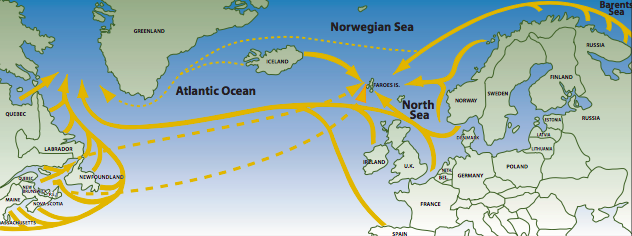Conservation groups, Greenland fishermen agree on 12-year salmon moratorium
Two generations of wild salmon to be protected in deal that will compensate fishermen for lost income.

Greenland’s commercial fishermen have signed away the right to catch $4 million worth salmon in the waters along the western coast of their country for the next 12 years as part of an effort to replenish North American and European stocks.
A similar deal with the Faroe Islands, in place since 1991, has also been extended, the Atlantic Salmon Federation and the North Atlantic Salmon Fund, two conservation groups, announced last week.
Under the agreement, the two organizations will compensate fishermen in both countries by spending an amount equal to the value of the uncaught fish on alternative economic development, scientific research and education initiatives focused on marine conservation.

A subsistence harvest by licensed recreational fishermen amounting to 20 tons per year for personal and family consumption will continue in Greenland. The groups would like to see the amount reduced further, but said they recognized the catch was essential for many communities.
But with the current catch at 45 million tonnes, the amount of salmon caught each year will be reduced by more than half, and will result in a significant increase in the number of fish reproducing, the two groups say.
“The best way to save North Atlantic salmon is to reduce the number killed,” said Chad Pike, the chair of the North Atlantic Salmon Fund.
The period of time is significant, according to the Atlantic Salmon Federation and the North Atlantic Salmon Fund, since salmon have a lifespan of five years. Once it comes into force in 2019, the moratorium will protect two generations of fish from commercial fishing.
[Indigenous peoples of the world’s coastlines are losing their fisheries – and their way of life]
When it comes to North Atlantic salmon, all roads lead to western Greenland and the Faroe Islands, with adults from rivers in Europe, the northeastern United States and the Canadian Maritimes converging there each year to feed before making the journey home to spawn.
Although Greenlandic fishermen do not specifically target North Atlantic Salmon, they are caught in what is known as “mixed-stock” fishing, a method that does not distinguish between different species. In 2017, this meant that 1.4 percent of the catch was deemed to have been from the U.S., where North Atlantic salmon is a federally protected species.
Complicating matters is the fact that the most valuable commercial fish are also those that are most necessary for rebuilding stocks. This was in part why Greenland’s KNAPK, the association of commercial fishermen and hunters that agreed to the deal, let a similar agreement expire in 2009.
During that seven years that moratorium was in place, the number of large salmon returning to North American rivers doubled. After it agreement expired, the numbers fell back to the previous level.